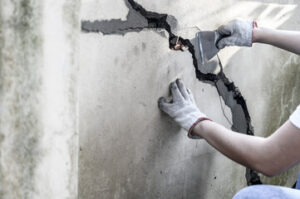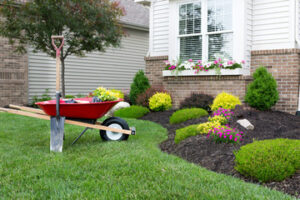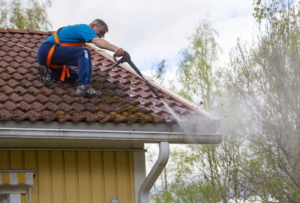Cracks in concrete can be a safety hazard, cause water penetration, and lead to mold or mildew. It’s important to get any cracks repaired as soon as they are noticed to avoid further damage.

Eco-efficient repair methods have to minimize resource use and GHG emissions throughout the life-cycle of concrete. They also have to achieve the desired performance level in terms of durability and costs.
Concrete cracks in slabs, driveways, sidewalks, patios and pool decks are common and relatively easy to repair. However, it’s important to understand how the crack forms and what the cause might be before you start repairing it. In some cases, it’s necessary to hire a professional concrete contractor to assess the situation and determine the best method of repair.
First, make sure the crack is clean. Scrub the crack with a wire brush and vacuum up all the debris. This step is crucial in ensuring that the crack filler will adhere to the concrete.
Next, apply a layer of bonding adhesive to the surface of the crack. This helps ensure that the crack filler will adhere to the existing concrete and prevents water from seeping into the crack and further deteriorating it.
After applying the bonding agent, let it dry. You can speed up the drying process by using a blow dryer. It is also a good idea to cover the area with plastic to protect it from stains and other damages while the concrete is repairing itself.
For small cracks, you can use a concrete caulk. Most of the time, these products are used in exterior applications like driveways and walkways, but they can be used indoors too (garage floors and basements, for example). The most important thing to remember about concrete caulk is that it doesn’t actually fix cracks; it just creates a seal on the tops of the cracks to keep water out.
For larger cracks, you will need a more substantial concrete patching product. This can be an epoxy or latex-based product, depending on the manufacturer’s specifications. The key is to follow the directions closely. Some of these products require mixing the components before application and others must be troweled into place. Once the product is applied, it will need to cure for a few days before the surface can be walked on.
Reinforcing Cracks
If a crack in concrete is structural in nature, it may be necessary to strengthen the structure to prevent further damage. Structural repairs involve placing additional steel in the structure to support loads that would otherwise cause further cracking and deterioration. The steel is anchored into the concrete with epoxy or grout, and is then used to support the additional load, thus relieving the cracks in the concrete.
When installing a reinforcement system it is important that the correct size of reinforcing bar is used. This is critical for achieving proper strength and durability of the new structure. In addition, it is imperative that the concrete is well cleaned before placing the bars into it. This will ensure the integrity of the repair and that it is not contaminated with unwanted substances.
In most cases, the failure of a concrete repair is due to the incompatibility between the repaired surface and the host concrete. This is caused by a number of factors, including chemical and physical interactions at the interface between the repair material and the host concrete. The most common incompatibility is a difference in shrinkage rate, which can lead to debonding and failure of the repair material.
Another way to increase the durability of a concrete repair is to use polymer-modified cementitious mixtures. This is accomplished by mixing dispersed or re-dispersed organic polymers into the hydraulic cement during its mixing. The polymers then coalesce into a co-matrix with the hydrated cement, significantly improving the flexural strength, bond strength, abrasion resistance and permeability of the repaired concrete.
One of the most common and effective methods of repairing cracked concrete is to “stitch” the crack. This is done by drilling an entry and exit hole across the crack and then running a series of U-shaped metal staples into it, anchoring them firmly in place with an epoxy or grout-based system. This is an efficient, cost-effective and long-lasting method of repairing concrete.
While increasing the durability of a concrete repair is important, it is also important to keep in mind that a significant portion of concrete repairs are carried out due to deterioration problems in existing structures. These repairs have a direct impact on the environment through depletion of natural resources and massive carbon dioxide emissions and inert waste production. Engineers need to focus on designing eco-efficient repair systems that attain specified performance levels while minimizing environmental impacts.
Filling Cracks
Concrete cracks are often caused by uneven drying, shrinkage and temperature changes. If not repaired promptly, they can lead to water seepage and further damage. There are several different approaches to concrete crack repair, depending on the overall goals of the project. Some approaches focus on structural bonding and others focus on stopping water flow. In either case, proper preparation of the existing concrete is essential. This includes removing any unsound concrete and cleaning the surface.
If the goal is to create a structural bond, epoxy injection may be the best option. This is a labor intensive process and requires the services of a skilled contractor. However, it can be very cost effective if the project is large enough.
For cracks that are 1/8 inch wide or narrower, the simplest approach is to fill them with a concrete patching product. This material is available in a variety of mixes, each formulated for a specific type of crack and cure time. Follow the directions on the product you select for your project.
Before you apply the concrete repair product, it is a good idea to make sure the crack is clean and dry. Generally, a mason’s trowel or putty knife will work. A stiff brush or wire brush can help loosen up any debris in the crack.
You will also need to prepare the area around the crack. This means spreading a tarp beneath the work area, if necessary, to facilitate cleanup and protecting the surrounding concrete from dust and dirt. It is also a good idea to wear appropriate protective equipment, such as gloves and safety goggles.
The next step is to “back-fill” the crack with a filler product. This will help prevent the concrete patch from settling into the crack and creating more problems. Backer rod is available in a range of sizes, so select a diameter that is slightly larger than the width of the crack you are repairing.
Finally, pour or trowel the concrete patching compound into the crack, again following the instructions on the product you choose. After it dries, smooth the crack with a masonry float, sandpaper or a wire brush to ensure that the repaired area blends in seamlessly with the surrounding concrete.
Repairing Leaks
Leaks are a major source of concrete damage and must be repaired promptly to protect structures and minimize environmental impacts. This type of repair requires a thorough inspection including visual inspection, pressure testing and acoustic monitoring to identify the location and extent of the leaks.
Once the leaks have been located, it is important to prepare the concrete surface before applying a repair material. For concrete surfaces that are not prone to movement, a simple concrete patching material can be used to seal the area around the leak. For concrete surfaces that are prone to movement, a penetrating concrete sealant may be required to ensure the integrity of the structure.
A common cause of slab leaks is aging plumbing lines that are susceptible to corrosion, shifting soil conditions and chemical reactions with metals in the soil. The first step in repairing slab leaks is to complete a comprehensive inspection and evaluation of the plumbing system.
After the leaks are identified, they can be repaired using a variety of methods. For small cracks and localized leaks, surface patching can be a quick and cost-effective solution. For larger slab leaks, epoxy injection is a popular technique that penetrates through the cracks to provide a watertight seal.
For tile tanks and piping, a shotcrete process is often used to repair leaks in the tank walls. This method can be highly effective, especially when combined with an acoustic monitoring program to identify delaminated areas that send back dull hollow sounds rather than the hard ring of sound concrete.
For broader concrete repairs, geopolymer concretes are an option that offers many environmental benefits. These new sustainable concrete materials are produced by combining alumino-silicate components such as fly ash and metakaolin with an alkali activator such as sodium hydroxide. These materials offer the potential to significantly reduce greenhouse gas emissions, compared with traditional concrete and cement products.
Whether you are repairing concrete cracks, waterproofing slabs or restoring concrete tanks and other infrastructure, it is critical to work with a professional concrete contractor that has the right equipment and training to get the job done correctly. Not only will a qualified concrete contractor save you time and money, but they will also use high-quality materials that are guaranteed to last. They will also provide a warranty on their work and have insurance to protect you in case of any accidents or injuries that may occur during the repair process.





